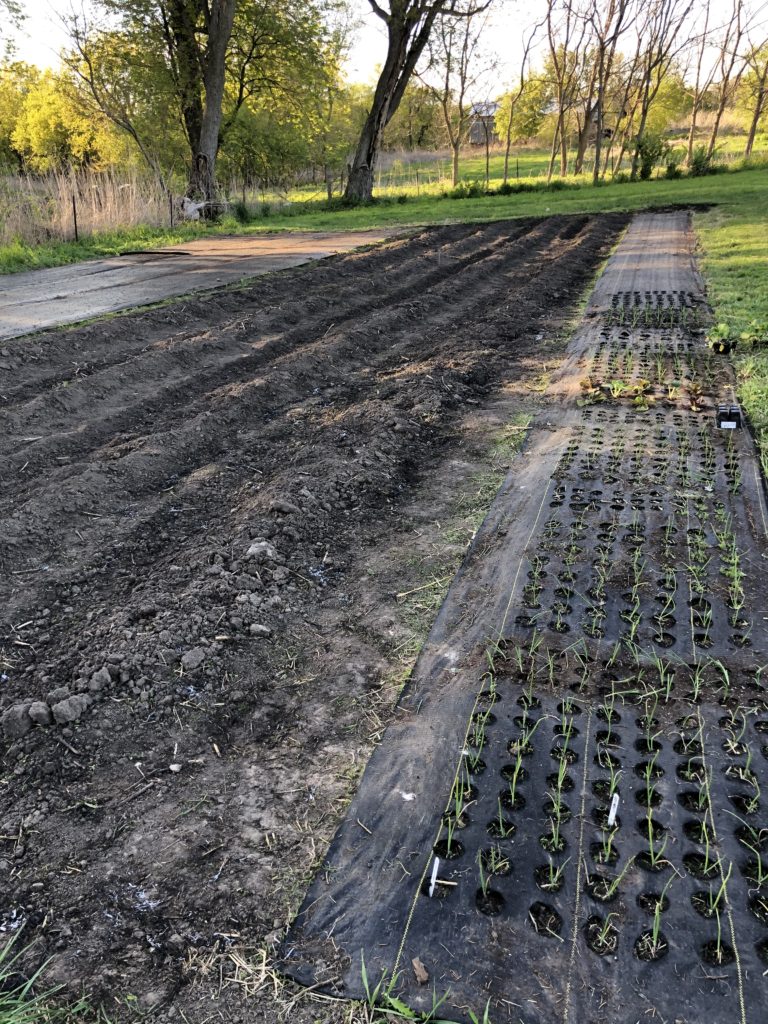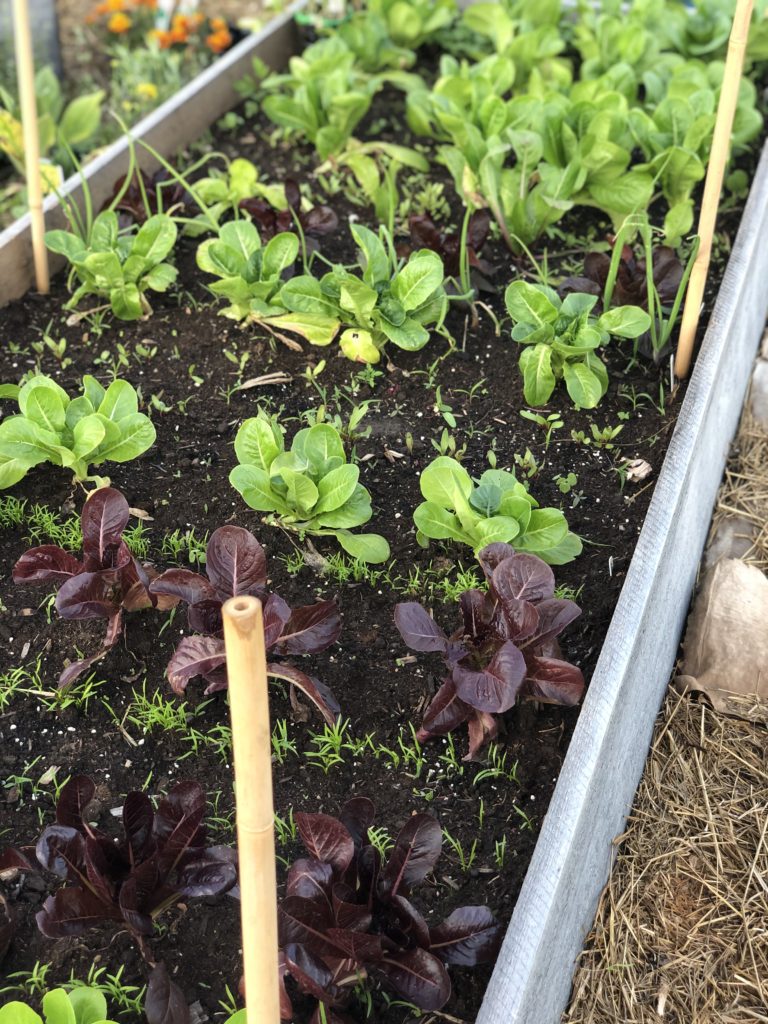This is a simple guide to starting a food garden on a budget…or, what I wish I had known when I started growing vegetables.
The simple seed starting guide
You only need three things to start seeds – dirt, seeds, and water. Yes, it is that simple. Books on growing will give you all sorts of complicated steps and those are helpful to improve germination and ensure healthy plants but when you read them, it can be intimidating.
The simplest, most affordable way to start a food garden is to grow vegetables from seed directly in the ground when conditions are right for that vegetable. This is called Direct Seeding. Conditions are affected by your location, weather, and the variety of vegetables you are growing. For example, we have a short growing season in SW Wisconsin so I start my longer growing vegetable (onions, tomatoes, peppers, and eggplant) quite early, 10-12 weeks early to ensure large healthy plants. I also grow very quantities of these vegetables and multiple varieties so it would be expensive to buy them from a nursery. I also have indoor grow lights and a greenhouse to assist with growing strong healthy seedlings, neither of which are budget-friendly.
There are still many vegetables that I grow from seed directly in the ground. Vegetables like carrots, lettuce, squash, kohlrabi, radish, turnips, potatoes, and many herbs, just to name a few! If you could grow just even some of those listed, what difference would that make to your family? Would it create more abundance in your life? Give you a measure of self-reliance?
When can I start direct seeding in my area?
You need to know your last frost date to accurately determine when you can start seeds.
I love the Garden Planning Calendar over on Garden.org, the National Gardening Association website. This a FREE tool that gives you approximate last frost dates when you enter your zip code. The best bit? The calendar also lists the most common vegetables, their seed starting indoors, transplant or, direct sowing dates based on your zip code for both Spring and Fall! Did I mention it’s FREE? So check out the Garden Planning Calendar ASAP to get started.
What should I grow?
I would use the Garden Planning Calendar to find vegetables and fruits that can be direct sown in your area and start there.
Grow what you love to eat. Do not grow broccoli if you hate broccoli. We are big believers in managing our resources as well as possible. Time is one of our most valuable resources and wasting it on things you won’t eat is pointless, no matter how good for you it may be. Let’s put it this way, I haven’t grown brussel sprouts in over 10 years because they smell like feet. Ugh. EDIT: So this is two years later (2023) and we love brussel sprouts now. A local brussel sprout farmer gave us some ideas on how to cook them and guess what is in the garden this year? Knowledge is power.
You can also read my posts on The One Thing Everyone Should Grow (homesteader or not) and My Top 5 Vegetables To Grow when you have limited space and a tight budget.
Where Should I start growing my food garden?
The vast majority of fruits and vegetables need 6 – 8 hours of direct sun per day. Most don’t like very strong afternoon light, which is also the hottest part of the day, so a measure of shade – at least for the more delicate plants would be appreciated. We often plant the more delicate veggies where they will receive a measure of shade from trellised plants in the afternoon.
So the first step is to find your growing space! Then you have to figure out how to grow.
Cheapest: In the ground. Remove the sod or top cover. Remove any stones, dig down at least 12 inches, and break up the soil. In my first garden, I just added a layer of compost after digging. It cost me about $14 in compost at the time. The only tools you need are a shovel and a rake. One tool to dig, the other to smooth over. The below photograph is not my first rodeo…

Less Cheap: You could also start seed outdoors in containers on your deck or balcony or planters around your yard. Many direct-seeded vegetables grow nicely in containers and planters. Some to try are herbs, lettuce (especially cut and come-again leaf lettuce mixes), chives, even some melons, summer squash, and radish. If your container is deep enough, root veggies like beets, carrots, and potatoes will grow well too. This is a more expensive startup. There is the cost of potting soil, containers, and tools. In addition, your yields won’t be as large but, there are ways to lower the costs.
We have grown potatoes in used food grade 3 and 5-gallon buckets we got from a bakery, for FREE. We did our own potting soil blend with sifted dirt from our yard, sand, compost, and peat moss. Soil recipes are available but we didn’t use one. Just don’t use plain dirt from your yard, it won’t drain or hold moisture properly. To maximize yields though, I recommend good potting soil – it’s worth the cost.
Most Expensive Start-Up. You can also start seeds in raised beds. You need to build a sturdy frame and block weeds from creeping in, we have used thick layers of newspaper and cardboard in the past. You’ll need to fill the bed with good draining, moisture-retaining soil. The cost will be at least $40 to set up, most likely $100 or more for a 4×8 bed, 12″ deep. Your costs will be wood, soil, and mulch. The mulch layer is important as raised beds don’t retain as much water as the ground, mulch helps keep the soil from drying out too fast.
On the plus side, you only spend that much money in year one and they can produce quite well. The gardens also require less weeding, are often easier for those with joint issues and conditions can be well monitored. I highly recommend the Square Foot Gardening method to really make the most of the space. A raised bed was the second garden space I grew in and found it worked beautifully. I have 6 raised beds in my gardens now and LOVE them for root vegetables and my sweet potatoes. This year I will be adding 2-4 more raised beds, which are also cold frames, for out-of-season gardening. Fresh greens in winter!

The Basic Seed Starting Method for All Seeds
- Prepare your planting area
- Moisten the surface
- Sow seed as per packet (spacing, depth etc)
- Cover the seed as per directions on the seed packet.
- Keep seed moist until sprouting – do not “flood” as this can wash seeds and sprouts away. Use a shower setting on your hose or a watering can and watch the weather.
- Once seeds have sprouted, water regularly but allow plants to dry out a little. Some plants need more water than others so read the growing directions on your seeds.
- Eventually, you will need to thin the plantings so that each plant has enough room to grow. This distance will vary per plant type, and where you have them growing.
When you need to start seed indoors…
If your location and your chosen fruit or vegetable seeds dictate that you need to start them indoors, you can read all about it in our Simple Seed Starting Indoors Guide.
In the end, I have three main tips for starting a food garden on a budget:
- Start smaller and grow your garden over time if you truly enjoy it
- Grow what you love to eat
- Grow as much as you can from seed to save money
Hope this gives you some ideas to get started! Happy Growing xoxox

[…] you need some ideas on how to get your garden started, try the Simple Guide To Starting a Food Garden on a Budget. If you are confused about what can be direct-seeded when, check out the Garden Planning Calendar […]